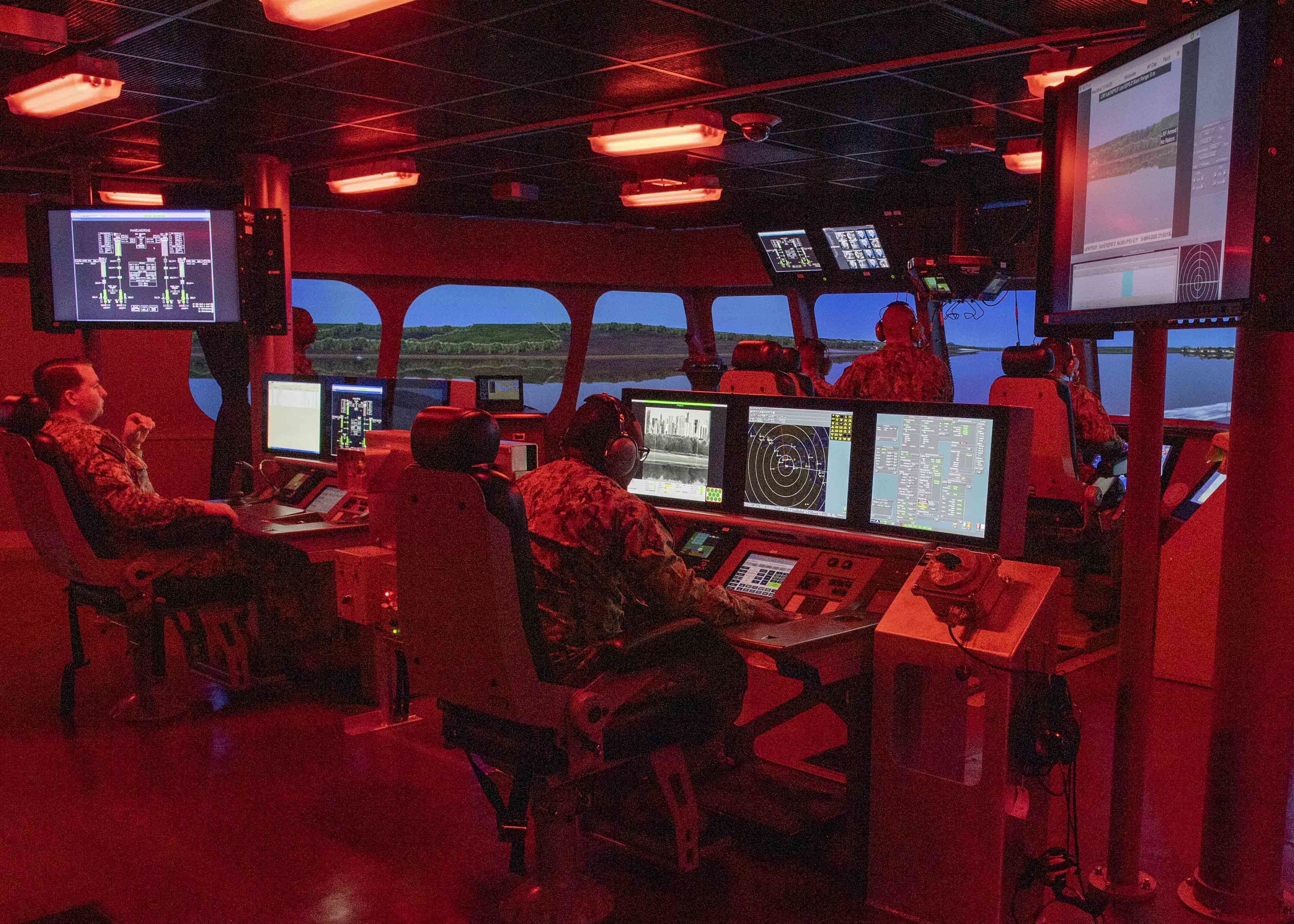
NAVAL BASE SAN DIEGO, Calif. – The eyes of a half-dozen crew of Littoral Combat Ship USS Jackson (LCS-6) were staring at computer displays, tracking contacts and consulting manuals in the warship’s dimmed pilot house as the bridge watch team guided the ship through foggy waters.
However, Jackson wasn’t at sea. The gold crew members of the San Diego-based LCS were working on their individual and team watch-standing skills in the integrated tactical trainer at LCS Training Center Pacific ahead of a navigation assessment. Other Jackson gold crew sailors worked on their Personnel Qualifications Standards and Train-to-Qualify requirements in virtual labs.
Crews enter the immersive trainers to work through simulated scenarios in a realistic, full-scale simulation, where they can fail without fear and unlimited do-overs.
“This is orientation. This is knowledge,” Capt. Dustin Lonero, the commanding officer of LCS Training Facility Pacific told USNI News. “So when they get to their ships, they are ready to integrate it at a much quicker pace.”
That’s particularly important for the LCS community, whose blue/gold crews rotate to their forward-deployed hull every four to five months and must be ready to hit the ground running and operate their ship. With few ships typically available for at-sea training at their home station, the LTF serves a key role to provide that needed training and certification for both individual sailors and crew of off-hull ships.
“Each sailor is valuable,” Lonero said. “You can’t afford to have a sailor who’s not up to speed.”
The simulated training systems, with integrated ship navigation and combat systems, are known as Surface Training Advanced Virtual Environment-LCS. LTF-Pacific has three full-sized spaces that replicate the pilothouse, with bridge wings and 180-degree window screens that enable high-res external imagery that can mimic the swells and movements of a ship underway. Consoles and stations – including for the officer-of-the-deck (OOD), junior officer-of-the-deck (JOOD) and readiness control officer (RCO) and interior communications – are exactly as they are in the real ships.
“Everything here is the exact same model you’ll see on ship,” Lt. Cmdr. George Bank, the LTF-Pacific’s executive officer, said during a recent tour.
About 80 military personnel along with 12 civilian workers and 30 contractors work at LTF-Pacific, plus an additional 30 contractors who provide maintenance as needed, officials said. An East Coast counterpart, LTF-Atlantic, was established in September 2022 in Mayport, Fla., for the LCS-1 USS Freedom fleet of ships. The LTF provides Train-to-Qualify courses that teach sailors new to LCS about its systems and train them to be watchstanders and Train-to-Certify courses for crew certification.
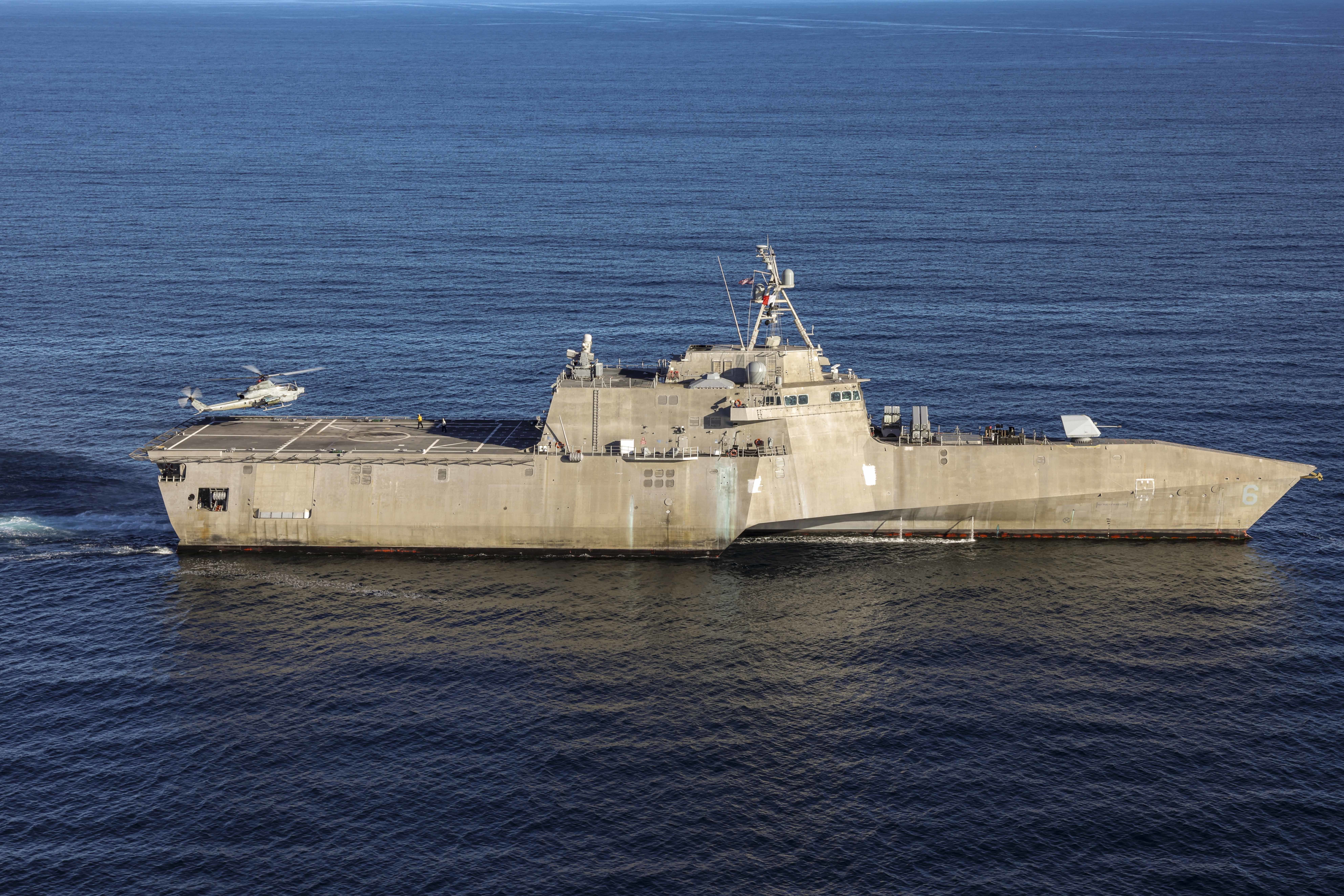
The LCS community has minimally-manned crews by design, with hybrid sailors taking on multiple responsibilities compared to surface warfare crews on other warships. Crews on deploying hulls rotate overseas to their ships, so foundational work to build and sharpen LCS-specific skills happens ashore, mostly in simulation trainers.
Sailors training at the LTF get oriented to their hull’s systems and equipment before stepping aboard, and “they can integrate with the crew quickly,” Lonero said. That’s important, he noted, amid manning gaps that don’t leave much time for that orientation once sailors get to their hulls.
Lonero took command on Nov. 1, when the LTF was established and renamed in a Navy realignment of Surface Combat Systems Training Command. The name change from Center for Surface Combat Systems and realignment define the command’s critical mission of training surface warfighters, according to the Navy.
Upgrades Ahead
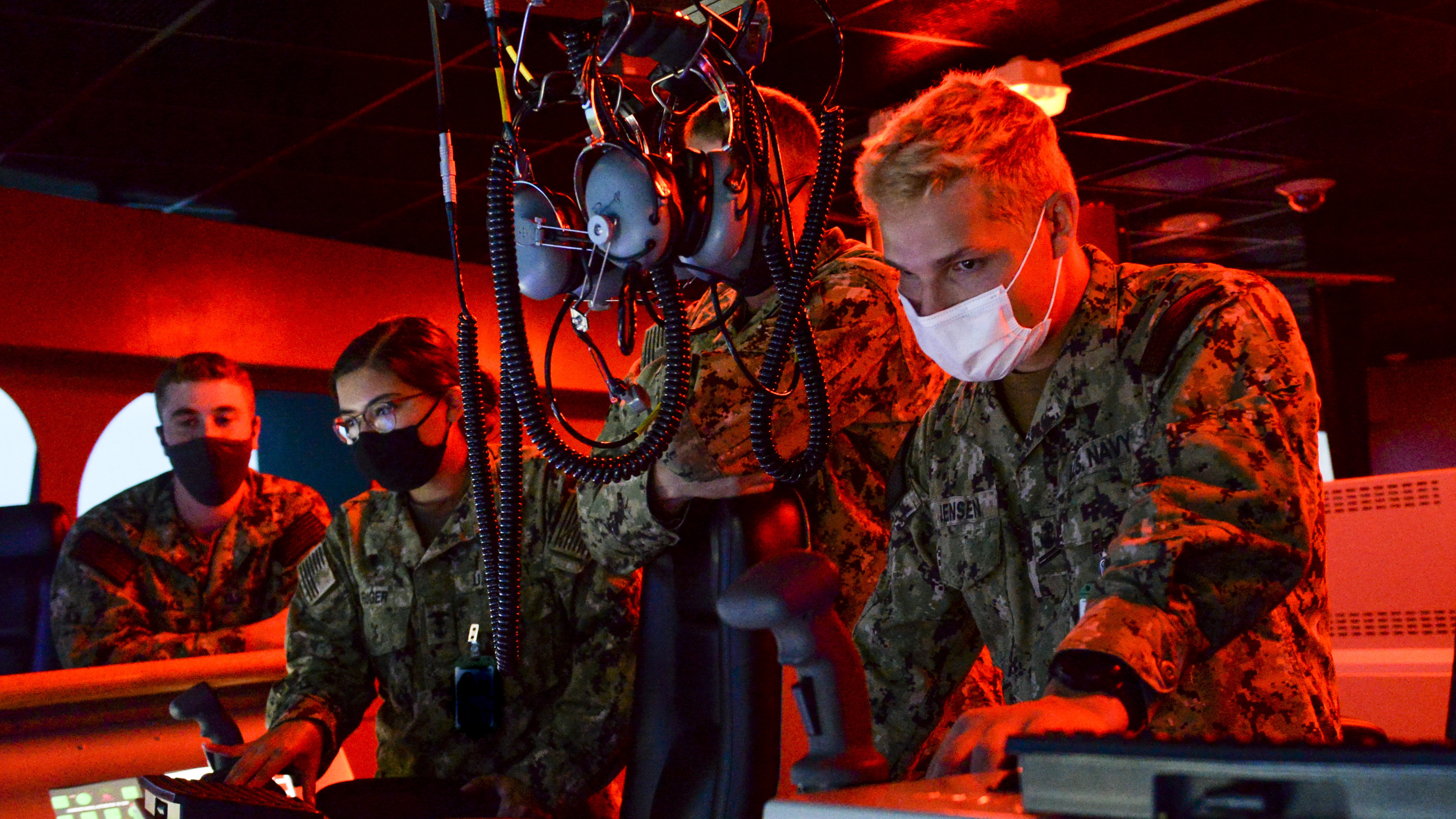
The $46.6 million LTF Pacific, which opened in 2017 in a renovated warehouse near the waterfront, has three integrated immersive trainers, three bridge trainers, a mission bay trainer and virtual reality labs where smaller groups of students learn the intricacies of their rate, watch duties and tasks. It provides both basic phase certification and sustainment training for crews that are off-hull or preparing to get underway for training certification or large-scale exercises.
The Alpha integrated trainer is down while it gets long-term upgrades and software updates until April, and Bravo trainer will follow in June, Lonero said.
“The big one that we have our eye on is the Lethality and Survivability upgrades,” he said.
Alpha trainer is funded for the L&S upgrades, which include more consoles and software upgrades and a new combat systems suite, starting in Fiscal Year 2024. Bravo and Charlie trainers also will be upgraded, but there’s no time frame yet.
“We are just trying to match the fleet so we can just service the legacy ships and service L&S ships as well,” he said. “We are looking at numbers and we’re kind of reading the tea leaves to see when the transitions are occurring so we can adjust our timelines accordingly.”
Consoles and computer suites will change, said Mike Mershon, director of LCS Training Facility Pacific.
“For LCS-2, it’s almost a complete gut job of the combat systems part. The bridge will be the same. The watch stations are going to be in the same space, but it’s a whole new combat systems. They’re standardizing it.”
“Just like any ship in the Navy, they’re constantly getting the new and the better,” Mershon said.
If the Navy moves ahead with changing LCS mission packages from surface to mine warfare, “then we’ll match the transition as well,” Lonero added. The facility already provides a mine countermeasures capstone course for minemen, “and eventually we’ll start doing MCM certification.”
“I think the Navy is still trying to come up with what they want to see on the certification and sustainment of an MCM mission package ship. So we are just trying to lean forward and we’re just trying to build our own,” and they plan to provide a proposal to Afloat Training Group, he added. “By next year, I think, hopefully that’s ironed out.”
Risks and Training Ashore
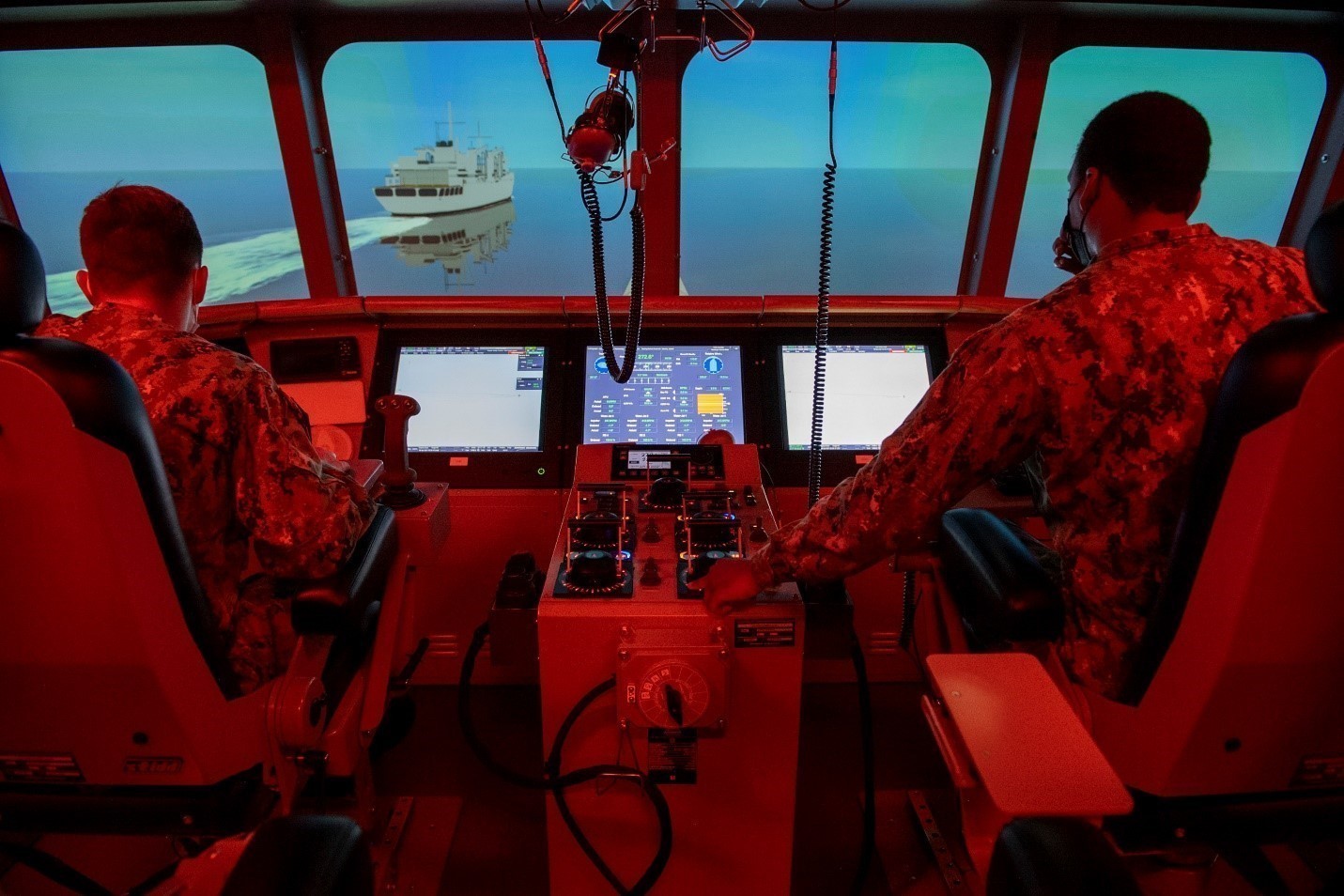
Simulated training lets crews train and work on crew coordination when they cannot get to sea. They can push the limits without the risk if underway, officials say.
“Anybody can be a great watchstander in (Southern California operating area) when the weather is great, when there’s no traffic. But how do you handle things when there’s some pressure on you, there’s a lot of traffic, the weather’s bad? How do you make decisions then?” Lonero said. “This gives a window for a CO to look through to see how the watchstanders handle those situations.”
Simulation trainers can push crews and bridge watch teams through stressful events. It’s a balance to provide enough challenges for the crew to learn, even to fail, and provide enough leeway “to control the ship as they see fit,” he said. “This is a good place to test that.”
“All those extra hours that you get in – whether it’s in BRM or crew cert or just coming in for stick time – is really valuable. It’s hard to get that out in SOCAL,” he added. “You don’t get close to what you’re seeing when you’re on deployment in the South China Sea, with two [PLA Navy] shadows and a ton of traffic and your radar is going down, or something like that. There are some situations that are tough to prepare for, but if you’re going through some of the scenarios that we have here, you’re going to have a leg up.”
That means replicating missions in real-world waters, where crews have to manage congested channels, tricky ports, rough weather and the peering eyes – and sometimes dangerous maneuvering – of foreign ships and patrol boats. Among the missions that LCS crews are asking for more lately are escort and freedom-of-navigation operations, the latter a particularly dicey mission in the South China Sea.
Filling Training Needs
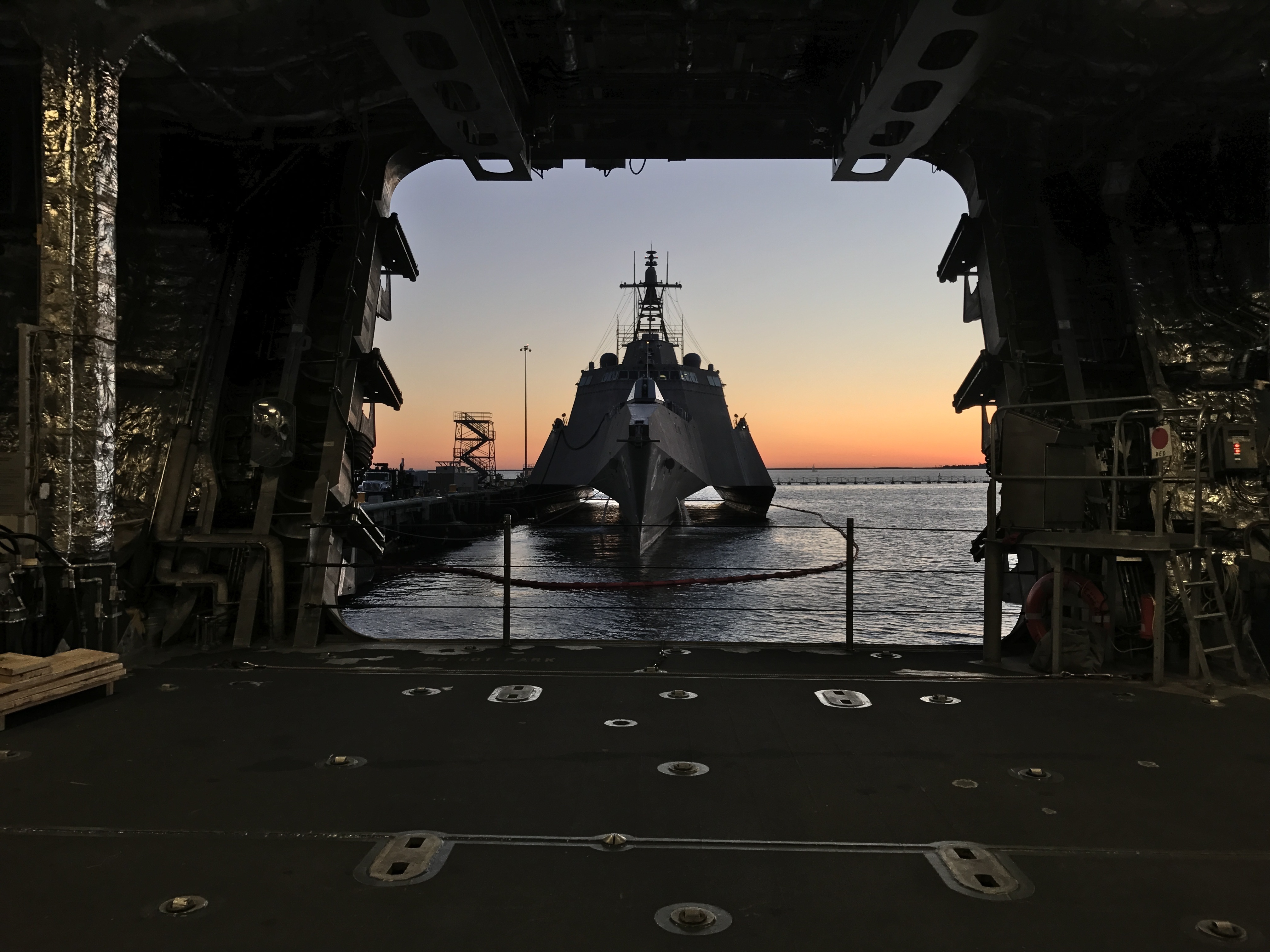
Unlike deploying warships that get time to train underway heading west from San Diego on deployment, the rotational nature of LCS crews that fly to their overseas port means they have to hit the ground running.
“It’s not your typical warm-up,” Lonero said. Other ships deploying from the West Coast have time to train before they reach Guam, “and it slowly starts picking up in the Philippines.” But for LCS crews, he said, it’s “boom, and you’re dealing with actual Chinese ships on your first underway.”
“So the more training that you can get so you’re ready to respond for that, the better.”
Lonero, whose career includes four Persian Gulf deployments on a frigate and cruiser, has skippered crews on three littoral combat ships – USS Gabby Giffords (LCS-10), USS Coronado (LCS-4) and, most recently, USS Montgomery (LCS-8). One year, he recalled, he flew to Singapore to meet up with his ship.
“We had about five days to turn over, and then it was turn-and-burn,” he said. “There’s no workup. It’s right away into heavy traffic, dealing with the Chinese (ships), operating with a ship we haven’t done in months.”
“It’s just a lot to handle,” he added. “So, you need this, I think, if we’re going to operate this model. This is crucial” for initial training. There’s no time to waste. A junior OOD reporting aboard after completing their capstone course might get two weeks of familiarization aboard and get qualified and stand a watch, he said. “You need to get them on that watchbill in weeks,” not months.
“They may not be fully qualified watchstanders yet because they’re a couple of weeks onboard,” Mershon said. But COs “know what they’re getting from students that we output.”
The simulation trainers are well utilized, with training going into the late night, officials said. “It’s a balancing act to see who we can train and when,” Lonero said, noting “we do get a lot of requests for specialized training we try to meet.”
He said that he didn’t realize the training opportunities at the LTF until he took command. So he’s working some initiatives to spread the word across the waterfront and this year hopes to kick off a “road show” to brief about LTF and educate skippers and crews about what the facility offers.
“If you want additional stick time, other than what’s available to you, you can sign up for a sustainment course,” he said. “I want to make sure all of that is communicated very explicitly to the COs so they understand what the LTF is capable of.”
Hands-on Focus
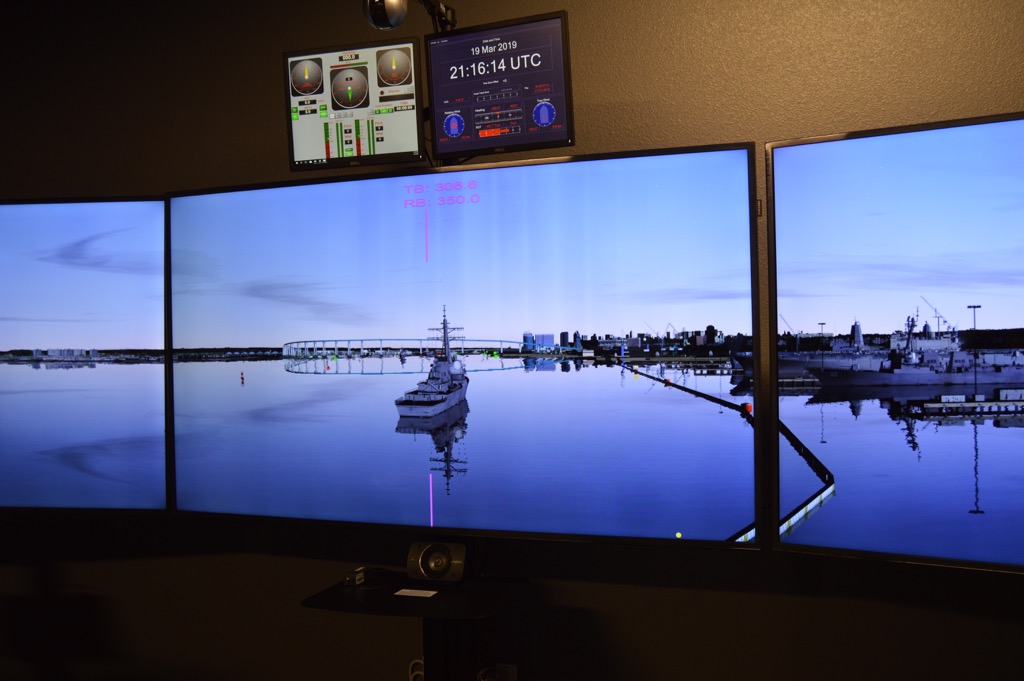
In one of the virtual reality labs, information systems technicians and electronics technicians worked through guided and unguided instruction on Day 25 of a 35-day Combat Systems Operator course. Seated at individual banks of monitors, students used avatars and waded into virtual environments as if they were aboard ship. With thick, red operating manuals in hand, they worked through the lesson plans to learn the various combat systems equipment, “from start-up to shut down,” said Electronics Technician 1st Class Anthony Reever, an instructor. The gaming-like control systems “are very intuitive.”
“This entire course is at your own pace,” Reever said. But “it’s encouraged for the students to interact with each other.”
Over in the expansive mission bay, a small group of sailors gathered outside a metal container as an instructor went over a mine warfare system. The space replicates the LCS mission bay and supports several courses, including Deck Operations and the Material Handling Equipment course. Here, sailors learn to operate forklifts to move around small metal containers, operate the boat skid for rigid-hull inflatable boats, and use a large Mobicon container handler to lift and move large containers around the large bay, said Chief Boatswain’s Mate Kendrick Taylor, an instructor. Students also get hands on the systems to operate the large stern door.
The LTF includes state-of-the-art briefing rooms where ship crews can gather for “hot washes” with instructors and review training scenarios and their watchstanders and individual performance. That can be very helpful, “as everybody has a different memory of what occurred,” Lonero said. “Here, you have the tape of what exactly happened. It makes for an effective debrief.”
It also provides each CO with detailed performance information on individual sailors, which can help in crafting watch bill sections and identifying those for leadership roles. “A lot of times, it could be different than what I saw myself,” Lonero said. “Here, seeing how teams work together… and getting feedback on the performance of the leadership, I think it’s an eye-opener.”





